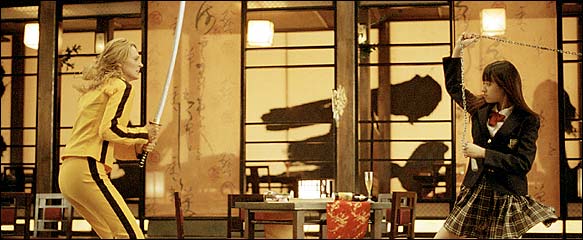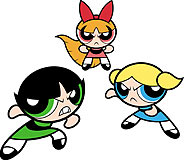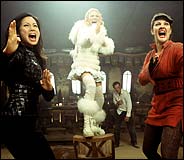|
By
JOHN LELAND
October 19, 2003

THE weekend after Arnold Schwarzenegger was elected governor of California,
the No. 1 movie in America was Quentin Tarantino's "Kill Bill:
Vol. 1." Given the proximity of the two events, it is tempting
to read them as a parable about women, violence and movies.
Mr. Schwarzenegger built his popularity on larger-than-life violent
screen characters, then parlayed this power in the real world to mount
his campaign for governor. On the stump, he sometimes reprised poses
or lines from his movies. Despite accusations from women that he groped
or sexually humiliated them, he got 43 percent of the female vote.
In "Kill Bill," which opened three days after the election,
women rise to a level of brutality previously reserved for men like
Mr. Schwarzenegger. Where women go in this movie, limbs fly. Heads
roll. Blood spurts in three shades of red.
In one scene the actress Chiaki Kuriyama, wearing a plaid skirt and
schoolgirl blazer, asks a man if he wants to have sex with her. When
he says yes, she stabs him.
"Do you still want to penetrate me?" she asks, pushing the
knife through his torso. "Or is it I who has penetrated you?"
If political clout follows from on-screen body count, as it seemed
to in California, you can only wonder what sort of political career
Ms. Kuriyama has in store. Payback, as they say, is a mother.
"Kill Bill," which presents its highly stylized violence
as visual repartee, is just the latest in a growing body of movies
and television shows featuring wild women wielding weapons. From the
animated "Powerpuff Girls" to the ABC series "Alias,"
in which Jennifer Garner plays a deadly secret agent in stretch fabrics,
women are wreaking damage in ways previously reserved for the hairier
sex.
Eight years after Lucy Lawless brought Xena the Warrior Princess to
the untamed world of syndicated television, the message from Hollywood
is clear: You've come a long way, baby. Now kill someone.
At theaters last week, where Mr. Tarantino's choreographed blood ballet
drew $31 million in its first seven days, the connection between violence
on-screen and power off-screen was not lost on the women in the audience.
About 40 percent of the ticket buyers on opening weekend were female,
according to Rick Sands, the chief operating officer of Miramax Films.
For a movie in which characters literally lose their heads, "that's
a very large female audience," said Paul Dergarabedian, president
of Exhibitor Relations, which tracks box office figures.
The carnage was part of the appeal. "It was empowering to women,"
said Carolyn Hrenko, 22, in downtown Denver on Wednesday, after watching
Uma Thurman cut a bloody swath through "Kill Bill." Ms.
Hrenko added: "For the most part, it showed women in a positive
light, they were all so tough."

In Houston, a real estate agent named Rachel Watkins, 45, who took
her husband to the movie, said she wanted to see it again, this time
with her 15-year-old daughter. "I think the girls need to look
at it instead of the silly movies," she said. "This is something
they should look for."
The aggression on the screen "reflects a trend in the broader
culture," said Martha McCaughey, an editor of "Reel Knockouts:
Violent Women in the Movies," who has also worked extensively
with women's self-defense programs. The numbers of women who study
martial arts, box, own guns and listen to Courtney Love and Foxy Brown
records have been on the increase for decades. It is only natural
for more women to be comfortable seeing characters like themselves
mix it up, as aggressors rather than just victims.
In the 1990's, Ms. McCaughey used to show film clips of actresses
in violent roles to women's studies classes, including scenes of Linda
Hamilton in "Terminator 2" or Rene Russo in "Lethal
Weapon 3." Her more politicized students objected to the clips,
she said. "They said, `If women are going to celebrate violence,
now we can't say that violence is a problem of a male-dominated society.'
"
But in recent years, younger women have been especially comfortable
with physical aggression, both on-screen and off, said Patricia Pearson,
author of "When She Was Bad: Violent Women and the Myth of Innocence."
Ms. Pearson said that "for younger girls, it doesn't contravene
their sense of gender identity."
The mayhem in "Kill Bill," which fills most of the movie,
is more clever pastiche than naturalistic gore. The audience knows
that the movie does not take its violence seriously. Like Mr. Tarantino's
other films, "Kill Bill" riffs copiously on other movies,
and what other movies are about — commercially successful ones
— is often violence.

Similarly, in "Charlie's Angels: Full Throttle," the violence
is more like a video game or music video, with explosions right and
left. In the television series "Buffy the Vampire Slayer,"
which finished its seven-year run in May, or "Charmed,"
women have supernatural powers, including violent ones, to go with
supercool wardrobes.
These characters allow female viewers to vent their anger vicariously,
said Joan Morgan, author of "When Chickenheads Come Home to Roost:
A Hip-Hop Feminist Breaks It Down." Ms. Morgan said she planned
to see "Kill Bill" with her girlfriends. "Women get
angry," she said. "Without socially accepted outlets for
that anger, flicks like `Kill Bill' are very cathartic."
Besides, she added, there's something especially engrossing about
a fight between women. "I grew up in the South Bronx, and nothing
stopped the flow of the neighborhood more than two women duking it
out in the street," she said. "There was a code of honor
when guys fought, but women were no-holds-barred. If you knew you
were going to be in a fight, you came to school with your hair in
braids, petroleum jelly on your face and clothing that couldn't be
stripped. Because women will strip each other down and attempt to
scar each other."
For all their differences, these portrayals send a common message
about power and society, said Henry Jenkins, director of the comparative
media studies program at the Massachusetts Institute of Technology.
"In popular culture, power gets represented through violence,"
he said. "It tells us who has the ability to kick, slash or shoot
an opponent." Characters who can blow things up on-screen can
wield corporate power or run for governor of California.
But even in these violent roles, screen heroines still cannot have
it all. Unlike classic Homeric male action heroes, who level cities
and slay suitors in order to win the girl, the protagonists of "Kill
Bill" and the "Charlie's Angels" movies do not drop
the armor for amour. They are, like the schoolgirl assassin played
by Ms. Kuriyama, literally impenetrable, in love or in war.
Audiences still maintain the Victorian prejudice that the sex act
compromises women, Mr. Jenkins said. "There is the sense that
for women to have sexuality is to give themselves over to the dominance
of men," he said.
"Kill Bill" is also a story about maternal loss. Though
the movie jumps around in time, the first thing Uma Thurman does chronologically
is grab her flat stomach and scream for the unborn baby she has lost.
The movie is her grisly revenge for being denied the role of bride
and mother.
Ann Kearney-Cooke, who runs the Cincinnati Psychotherapy Institute
and works with adolescent girls, said that these depictions of violently
powerful women, often created by men, are actually debilitating to
women in the real world. "What's going on is that as women have
gained power economically and politically, the message has been that
to be successful, you have to be like a man," she said. "That's
carried through to roles like this. This acting hypermasculine is
a way of glorifying men, not women."
At a Times Square theater last week, any sexual politics in "Kill
Bill" washed over Justin Lowrie, 33, a graphic designer. "It
didn't even dawn on me that it was women doing the violence,"
he said.
As with Mr. Schwarzenegger's movies, the real star of "Kill Bill"
is the violence, not the people who perpetrate it. They are more an
extension of set design or special effects — which raises a
whole other set of gender questions, for another day.
Copyright 2003 The New York Times Company | Home | Privacy Policy
| Search | Corrections | Help | Back to Top
|
|
|